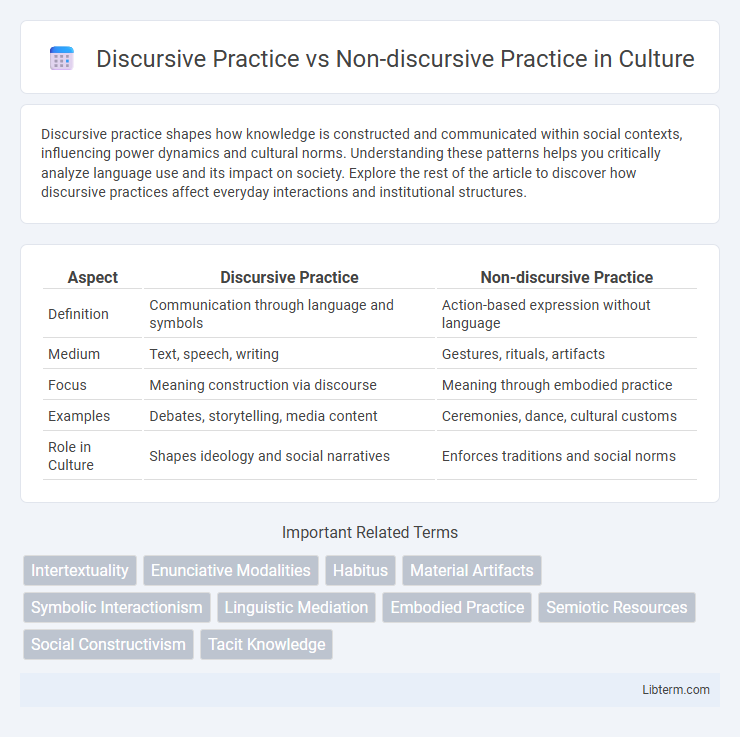Discursive practice shapes how knowledge is constructed and communicated within social contexts, influencing power dynamics and cultural norms. Understanding these patterns helps you critically analyze language use and its impact on society. Explore the rest of the article to discover how discursive practices affect everyday interactions and institutional structures.
Table of Comparison
| Aspect | Discursive Practice | Non-discursive Practice |
|---|---|---|
| Definition | Communication through language and symbols | Action-based expression without language |
| Medium | Text, speech, writing | Gestures, rituals, artifacts |
| Focus | Meaning construction via discourse | Meaning through embodied practice |
| Examples | Debates, storytelling, media content | Ceremonies, dance, cultural customs |
| Role in Culture | Shapes ideology and social narratives | Enforces traditions and social norms |
Understanding Discursive Practices
Understanding discursive practices involves analyzing the ways language constructs and shapes social realities through communication, discourse, and interactions. These practices emphasize the role of spoken and written language in producing meaning, influencing power relations, and maintaining cultural norms within society. Examining discursive practices reveals how narratives, ideologies, and identities are continuously negotiated and reproduced through discourse.
Defining Non-discursive Practices
Non-discursive practices refer to actions, behaviors, and routines that convey meaning without relying on verbal or written language, encompassing gestures, rituals, and symbolic performances. These practices shape social reality by embedding cultural norms and values through embodied actions rather than explicit discourse. In contrast to discursive practices, which are centered on language use and communication, non-discursive practices emphasize materiality and performativity as fundamental components of social interaction.
Key Differences Between Discursive and Non-discursive Practices
Discursive practices involve the use of language, communication, and text to construct social reality and meaning, emphasizing interpretation and dialogue within social contexts. Non-discursive practices relate to actions, behaviors, and material activities that do not primarily rely on verbal or written communication, such as physical tasks or rituals. Key differences include the reliance on linguistic structures in discursive practices versus the embodied, performative nature of non-discursive practices, highlighting how meaning is created through language compared to direct action.
Historical Context of Discursive and Non-discursive Approaches
Discursive practices involve the use of language, symbols, and communication to shape social realities, deeply rooted in historical contexts such as the rise of structuralism and post-structuralism in the 20th century, which emphasized the role of discourse in constructing knowledge and power relations. Non-discursive practices focus on material actions, behaviors, and institutional processes, drawing from historical developments in anthropology and sociology that prioritize observable social activities beyond language. The historical evolution of these approaches reflects shifts in understanding social phenomena, with discursive methods highlighting the interpretive frameworks and non-discursive methods emphasizing tangible social practices.
Discursive Practice in Communication and Language
Discursive practice involves the use of language and communication as a means to construct meaning, negotiate identities, and shape social realities through dialogue and text. It emphasizes the active role of discourse in organizing knowledge, influencing power dynamics, and reinforcing cultural norms within communication processes. Analyzing discursive practices reveals how language functions beyond mere information exchange, highlighting its impact on social interaction and meaning-making.
Non-discursive Practice in Social and Cultural Contexts
Non-discursive practice involves actions, behaviors, and symbolic expressions that convey meaning without relying on language or explicit verbal communication. In social and cultural contexts, non-discursive practices such as rituals, body language, art, and dress codes play a crucial role in reinforcing cultural norms, transmitting values, and shaping identities. These practices operate beneath conscious awareness, often sustaining power structures and social hierarchies through embodied and performative means rather than through spoken or written discourse.
The Role of Power in Discursive and Non-discursive Practices
Power shapes discursive practices by influencing language, discourse structures, and meaning production within social interactions, reinforcing dominant ideologies and social hierarchies. In non-discursive practices, power manifests through material actions, institutional policies, and embodied behavior that sustain or challenge power dynamics outside verbal communication. Both practices interlock to reproduce or resist power relations, highlighting the entwined nature of discourse and action in societal control mechanisms.
Examples of Discursive Practices in Daily Life
Discursive practices involve the use of language and communication to construct social realities, such as participating in conversations, writing emails, or engaging in debates. Examples include classroom discussions where ideas are exchanged, social media interactions that shape public opinion, and workplace meetings that influence decision-making processes. These practices demonstrate how discourse structures knowledge, power, and social relationships in everyday contexts.
Non-discursive Practices in Institutions and Structures
Non-discursive practices in institutions and structures refer to actions, routines, and material processes that shape social realities without relying on language or explicit communication. These include organizational rules, rituals, and physical arrangements that regulate behavior and reinforce power dynamics beyond verbal discourse. Such practices sustain institutional norms and inequalities by embedding authority and control in everyday non-verbalized activities.
Implications for Research and Analysis
Discursive practice involves the analysis of language, communication, and meaning-making processes, enabling researchers to uncover ideologies, power relations, and social constructs embedded in texts or interactions. Non-discursive practice focuses on material or behavioral elements, such as actions, objects, or institutional structures, providing empirical data for understanding social contexts beyond language use. Combining both approaches enhances research depth and validity by integrating interpretative insights with tangible evidence, facilitating comprehensive analysis in social sciences.
Discursive Practice Infographic

 libterm.com
libterm.com